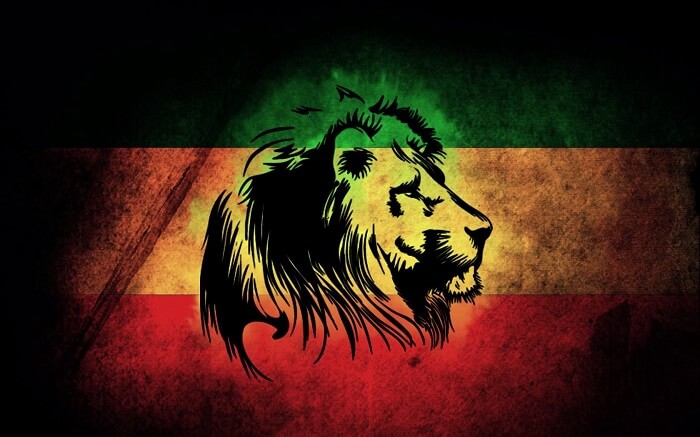When most people hear the word Rastafarianism, they think of Bob Marley…and that’s about it. Very few people outside of Rastafarian communities know anything about this complex and inspirational faith. In the article below, we’ll go through some of the core Rastafarian beliefs and practices. By the time you’ve finished this piece, you’ll have a better grasp of this relatively new pan-African religion.
Where Did Rastafarianism Come From?

We’ll start this post by briefly examining the roots of Rastafarianism. Most Rastafaris trace the beginning of their religion back to a prophecy made by Jamaican Black nationalist Marcus Garvey. Garvey famously told his followers that a Black king would soon arise in Africa. Rastafaris believe Garvey was referring to the 1930 coronation of Haile Selassie I of Ethiopia.
Believers started calling themselves Rastafaris after one of Selassie’s alternate names: Ras Tafari Makonnen. In addition to celebrating the Second Coming of Christ in the form of King Selassie, Rastafaris have many important practices outsiders don’t know much about. Now that you have a basic understanding of the origins of Rastafarianism, let’s explore eight Rastafarian beliefs and practices in greater detail.
1. Diet Is a Major Part of the Rastafarian Beliefs
It is common for Rastafaris to eat a strict vegetarian diet. This clean diet is officially called I-tal, which roughly translates to “natural.” Most Rastafaris want to consume foods and drinks that are “of the earth,” so they try to get as many fruits and veggies into their daily diet as possible. Even if a Rastafari decides to eat meat, s/he is strictly forbidden from eating pork.
Rastafaris can eat fish, but most won’t eat any fish longer than a foot. Rastafaris believe alcoholic beverages, coffee, and milk have a corrupting influence on one’s spirit and advise refraining from drinking them. However, the majority of Rastafaris have no problem with drinking organic herbal teas.
2. Weekly Reasoning Sessions
While Rastafaris claim their true temple is their body and believers don’t need an approved “church space” to worship in, there are a few Rastafarian community centers in countries like Jamaica. Generally, Rastafaris meet in fellow believer’s house or in a Rastafarian center every week for what’s known as a “Reasoning session.” During one of these sessions, group members usually sing, pray, and discuss spiritual issues together.
The word Nyabingi is used to describe a musical celebration; so if Rastafaris only sing and dance at their Reasoning session, they sometimes call it a Nyabingi session. Oftentimes Rastafaris use marijuana (aka ganja) to aid them in meditative practices, heighten their sense of community, and calm the mind.
According to Rastafarian beliefs, marijuana is a sacred herb that helps them transcend the corrupting influences of this physical world. They use various sections of the Bible to justify their consumption of marijuana such as Psalm 104:14 and Exodus 10:12. Marijuana is so highly valued by Rastafaris for its spiritual properties that it is never called just “cannabis” or “pot.” Instead, Rastafaris use reverential terms for this medicinal herb like “holy herb” and “wisdom weed.”
3. Growing Hair in Dreadlocks

Many Rastafaris grow out their hair in dreadlocks to symbolize the Lion of Judah’s mane. The key verse quoted in defense of this practice is Leviticus 21:5. Dreadlocks are seen as a symbol of defiance towards the demonic influence of “Babylon.” For Rastafaris, Babylon refers to all the spiritually deadening forces of the materialistic world.
4. Rastafarian Beliefs On Race
A few traditional Rastafarian beliefs about race are that members of the Black race are the descendants of the Biblical Israelites and that they are the superior race on this planet. Many also believe that Jesus was actually a Black man and that the forces of Babylon have kept vital information out of the Bible to keep Blacks in a subordinate position.
Rastafaris see the White race as the greatest example of the evils of worldly Babylon throughout history. While most Rastafaris don’t hate White people for being White (indeed, there are many White Rastafaris today), they do believe that Black people are spiritually superior and that Whites have done a great disservice to the world by persecuting the Chosen Race. Rastafaris believe that the Black race will take its rightful place as the supreme race on this planet after the Black diaspora repatriate to Africa.
5. Symbolism of Rastafarian Flag
The Rastafarian flag is composed of the following three colors in horizontal lines: green, gold, and red. On the top, the green line symbolizes the vegetation of both Jamaica and Ethiopia. The middle gold line symbolizes the future wealth of the African nation.
Finally, the bottom red line represents the blood spilled by ancestors and martyrs for the Rastafari cause. Some Rastafari flags also have the Lion of Judah in the center. Unsurprisingly, Ethiopia’s official flag is composed of the same three colors on the Rastafarian flag. However, the Ethiopian flag also has a blue circle in the middle with a yellow pentagram.
6. Study Of The Amharic Language
Rastafaris who are serious about their practice may try to master the Amharic language. Amharic is classified as an Afro-Asiatic language and is primarily used by residents in central Ethiopia. Today, Amharic is the official language of the Ethiopian Orthodox church.
According to Rastafarian beliefs, Amharic is a holy language uncorrupted by European colonialism. Learning Amharic is supposed to help members of the Black diaspora connect with their African roots and drive off the forces of Babylon.
7. The Uplifting Practice Of Lyaric
Another interesting part of the Rastafarian faith is the practice of Lyaric. Sometimes referred to as “I-talk” or “Dread-talk,” Lyaric refers to a conscious modification of the English language. Many Rastafaris regard English a decadent and even demonic language inspired by Babylon.
People practicing Lyaric change certain words and grammatical structures in English to better facilitate spiritual growth and understanding. One example of how Rastafaris practice Lyaric is by using the term “livication” rather than “dedication.” Rastafaris got rid of the “dead” connotation in the word “dedication” and infused it with the more uplifting “live,” hence: livication.
8. Major Rastafarian Holidays

Every major religion annual celebrations and Rastafarianism is no different. One unique holiday to Rastafarianism is Groundation Day on April 21st. This holiday commemorates Haile Selassie’s famous visit to Jamaica in 1966. Usually Rastafaris meet on this day and perform a Nyabingi session to recall this joyous occasion.
Another important holiday for Rastafaris is Marcus Garvey’s Birthday on August 17th. On this day, Rastafaris meet to remember Garvey’s life and work and to reflect on his role in spreading the “Back to Africa” movement. Usually Rastafaris recite uplifting poetry, sing, and dance on this holiday.
A few other important days on the Rastafari calendar include the Ethiopian New Year’s Day (September 11th), the Crowning of Haile Selassie I (November 2nd), and Ethiopian Christmas (January 7th).
Rastafarian Beliefs: A Spiritual Way Of Being In The World
As of today, about one million people around the world are adherents of Rastafarianism. It’s estimated that 1.1 percent of the Jamaican population identifies as Rastafarian. Hopefully this article has helped you understand some of the core Rastafarian beliefs and customs.
As you can see, Rastafarianism is far more than just an excuse to smoke pot. People who are serious about their commitment to the Rastafarian path are just as dedicated to communion with the divine as other spiritual seekers around the world.
